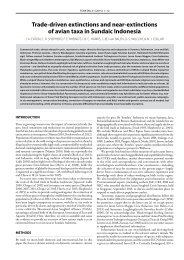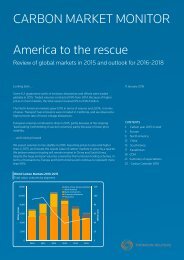Emissions Trading Worldwide
1TbjEHd
1TbjEHd
Create successful ePaper yourself
Turn your PDF publications into a flip-book with our unique Google optimized e-Paper software.
Shanghai (Pilot) <strong>Emissions</strong> <strong>Trading</strong> System<br />
in force<br />
emissions coverage (Mtco 2 e, 2015)<br />
Liable entities<br />
160 190<br />
Gas coverage<br />
allocation<br />
Offsets & Credits<br />
co2 only<br />
auctioning & free allocation<br />
domestic<br />
On 26 November 2013, Shanghai was the second Chinese region,<br />
after Shenzhen, to start its pilot ETS. The pilot covers around half<br />
of the city’s emissions, including industrial and non-industrial sectors<br />
like transportation. Shanghai completed its second compliance<br />
period in June 2015.<br />
basis of production data, are possible. Auctioning or other forms of allocation<br />
may be introduced during the pilot phase.<br />
COMPLIANCE PERIOD One year (30 June)<br />
Flexibility<br />
background information<br />
Overall Ghg <strong>Emissions</strong> (excl. LULUCF) 297.7 MtCO 2 e (2012)<br />
GHG Reduction Targets By 2015: (12 th Five Year Plan): 19% reduction in carbon<br />
intensity compared to 2010.<br />
ets size<br />
Cap 160 MtCO 2<br />
emissions coverage<br />
Banking and borrowing Within the pilot phase, banking is allowed across<br />
compliance periods. Borrowing is not allowed.<br />
Offsets and Credits Quantitative Limit: Domestic project-based carbon offset<br />
credits — China Certified Emission Reduction (CCER)— are allowed. The use<br />
of CCER credits is limited to 5% of the annual allocation. Qualitative Limit:<br />
Credits for reductions that were realized before January 2013 cannot be used<br />
for compliance.<br />
PRICE MANAGEMENT PROVISIONS If prices vary more than 10% in one day, the<br />
Shanghai Environment and Energy Exchange can take price stabilization<br />
measures, temporarily suspend trading or impose holding limits.<br />
covered<br />
not covered<br />
compliance<br />
57%<br />
43 %<br />
GHG Covered CO 2<br />
Sectors & THRESHOLDS The following sectors are covered: airports, aviation,<br />
chemical fiber, chemicals, commercial, electricity, financial, hotels, iron and<br />
steel, petrochemicals, ports, non-ferrous metals, building materials, paper,<br />
railway stations, rubber, textiles, paper, rubber. Inclusion thresholds: For<br />
power and industry: 20,000t CO 2/year. For non-industry: 10,000t CO 2/year, considering<br />
both direct and indirect emissions.<br />
Point of regulation Mixed: Both direct emissions from the power sector<br />
and indirect emissions from electricity (and heat) consumption are included in<br />
the scheme. Electricity prices are regulated in China, and therefore a scheme<br />
based on direct emissions alone would not induce a pass-through of carbon<br />
costs via the electricity price, and would not incentivize demand-side management<br />
of electricity. The system therefore covers emissions from the power sector<br />
upstream and other sectors downstream.<br />
Number of liable entities 190 (2015)<br />
MRV Reporting Frequency: Annual reporting of CO 2 emissions.<br />
Verification: Third-party verification is required. Framework: The Shanghai<br />
Development and Reform Commission (DRC) has released guidelines for monitoring<br />
and reporting for the following nine sectors: Iron and steel, electricity,<br />
building materials, non-ferrous metals, textiles, paper and pulp, aviation, large<br />
buildings (hotels, commercial and financial) and transport stations.<br />
Enforcement Penalties for failing to submit emission report or verification<br />
report on time or providing fraudulent information range from CNY 10,000 (EUR<br />
1,309) to CNY 50,000 (EUR 6,544).<br />
Between CNY 50,000 (EUR 6,544)–CNY 100,000 (EUR 13,088) can be imposed<br />
for non-compliance, besides surrendering the adequate amount of allowances.<br />
On top of the financial sanctions, further sanctions may be imposed, e.g., entry<br />
into the credit record of the company, publication on the internet, cancelation<br />
of ability to access special funds for energy conservation and emissions reduction<br />
measures.<br />
other information<br />
Phases and Allocation<br />
<strong>Trading</strong> periods Three years (2013–2015) 1<br />
allocation One-off free allocation for 2013–2015 based on 2009–2011 emissions,<br />
considering company growth and benchmarks for certain sectors (electricity,<br />
aviation, ports and airports). Ex-post allocation adjustments, e.g., on the<br />
Institutions involved Shanghai DRC (Competent authority), Shanghai<br />
Environment and Energy Exchange (<strong>Trading</strong> platform)<br />
1 Initially, the seven Chinese pilot ETS were scheduled to end after three compliance years and be<br />
replaced by the national ETS in 2016. However, as the national ETS will not start before 2017, the pilots<br />
will likely be extended until then.<br />
international carbon action partnership<br />
63




